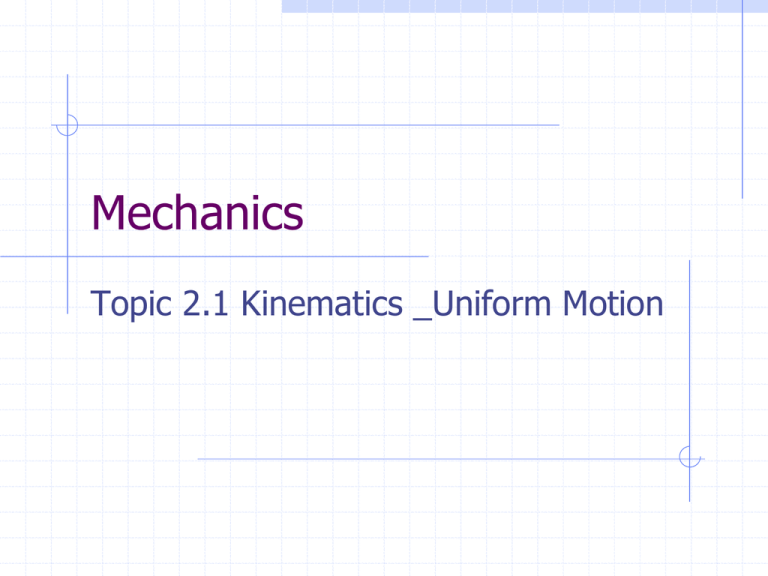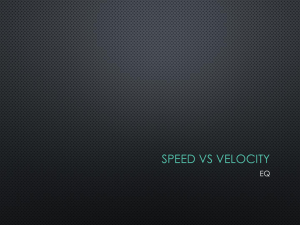uniform_motion-class_of_2014
advertisement

Mechanics Topic 2.1 Kinematics _Uniform Motion Mechanics The branch of physics involving the motion of an object and the relationship between that motion and other physics concepts Kinematics is a part of mechanics that studies motion in relationship to time. In kinematics, you are interested in the description of motion Not concerned with the cause of the motion (Dynamics) Quantities in Motion Any motion involves three concepts Displacement Velocity Acceleration These concepts can be used to study objects in motion and called the parameters of the motion. Displacement Defined as the change in position of a body when it moves from an initial position to a final position x xf xi f stands for final and i stands for initial May be represented as s or y if vertical Units are meters (m) in SI. Vector quantity Displacement Displacement is a vector quantity. Needs both magnitude and direction to be completely described Generally denoted by: boldfaced and an arrow over the letter + or – sign is also used if motion is along one direction: ∆s = +70, ∆s =-60 Displacement Versus Distance The displacement of an object is not the same as the distance it travels Example: In the adjacent picture, what is the displacement? What is the approximate distance traveled? Kinematic Concepts- Speed Is the rate at which distance is covered by an object. Or the distance covered per unit time Scalar quantity Two types of speed: Average speed Instantaneous speed Average vs Instantaneous Speed Average Speed is the ratio of the total distance (d) covered by the object to the time interval (t) over which the distance was covered. Average Speed (v) = total distance (d) total time (t) Average speed does not tell us about the variation in the speed throughout the journey. Instantaneous Speed is the speed at a specific instant of time. Be Knowledgeable! Distinguish between Instantaneous and average speed. (May 2012- 2 marks) average speed is the speed over a period of time/distance; instantaneous speed is the speed at a particular instant in time/point in space; Kinematic Concepts- Velocity Is the rate at which displacement is covered Velocity is a vector quantity Average vs instantaneous velocity The average velocity is the ratio of the total displacement (∆s) covered by the object to the time interval (∆t) over which the displacement was covered. Average velocity= = total displacement = total time ∆𝑠 ∆𝑡 Instantaneous Velocity Is the velocity at any one instant v = s t Where t is tending towards zero The instantaneous velocity of an object at point P is its velocity at the instant it passes P and is the average velocity of the object calculated over a infinitely small (but not zero) distance around P. Speed vs. Velocity Cars on both paths have the same average velocity since they had the same displacement in the same time interval The car on the blue path will have a greater average speed since the distance it traveled is larger Acceleration When the velocity of an object changes, we say that it accelerates Velocity can change by: Changing its magnitude, and/or Changing its direction Acceleration is the rate at which velocity is changing or change in velocity per unit time Acceleration is a vector quantity SI Unit is ms-² v vf vi a t tf ti u and vo are also used for vi More about Acceleration v vf vi a t tf ti The above equation refers to average acceleration that takes place over a period of time Instantaneous acceleration refers to a specific instant of time when the time interval ∆t tends to zero. Uniform Motion Constant velocity Constant direction, and Constant speed Acceleration is zero (Velocity shown by red arrows maintaining the same size) Graphical analysis What information can we get from the ticker tape and from the graphs? Graphical analysis What information can we get from the ticker tape and from the graphs? Graphing Motion –Uniform Motion in the positive sense Uniform motion in the positive sense Acc = 0 Velocity is positive and constant= 12 (unit) Position-time graph is a straight increasing line whose slope is equal to the velocity (12) Area under the velocity-time graph gives the displacement of the object (Area = 12 * 15 = 180) Graphing Motion –Uniform Motion in the negative sense Uniform motion in the negative sense Acc = 0 Velocity is negative and constant ( -12). The negative sign means that the object is moving in the negative sense. Position-time graph is a straight decreasing line whose slope is equal to the velocity ( -12) Area under the velocity-time graph gives the displacement of the object (-12 * 15 = -180) Notions about Uniform motion Graphs Uniform motion Displacement-time graph: the graph is a straight line Gradiant is the uniform velocity Positive gradient: object moving forward Negative gradient: object moving backwards Uniform motion Velocity-time graph: the graph is straight horizontal line Area under graph gives the change in displacement Positive area: positive displacement Negative area: negative displacement Be a Thinker! 1) The above graph shows four different phases of motion. For each phase: a. Identify the type of motion and direction b. Find the velocity c. Draw the velocity-time graph 2) For the whole journey, determine: 1) the total displacement and total distance. 2) the average velocity and average speed. Uniform Motion Equation x = x0 + vt Or s = s0 + vt






